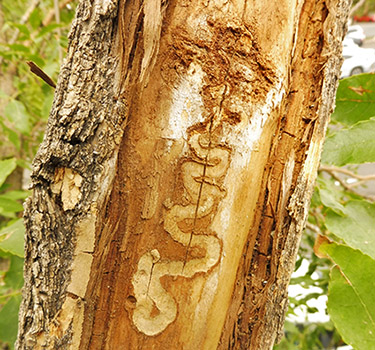New detection close to recent confirmation in Broomfield
WESTMINSTER, Colo. – National and state experts have confirmed the presence of emerald ash borer (EAB) – an invasive, highly destructive tree pest – in the City of Westminster, north of Denver. This detection represents the second confirmation of EAB in Colorado outside of a federal quarantine, with both detections occurring in the last month.

Photo: City of Westminster
EAB was first confirmed in Colorado in 2013, in the City of Boulder. Since then, the pest has been confirmed in five other municipalities in Boulder County within the quarantine, as well as in Broomfield in late August.
It is unknown whether EAB arrived in Westminster by natural spread or via accidental human transport, such as in firewood or other raw ash material. After the recent confirmation of this pest in adjacent Broomfield, City of Westminster forestry staff conducted further investigation and discovered the pest in ash trees near 128th Avenue and Zuni Street.
They delivered the insect to the Colorado Department of Agriculture and Colorado State University experts, who first confirmed it as being EAB; it was then confirmed a second time this week by a national EAB expert in Brighton, Mich.
Although this detection, like the one in Broomfield last month, occurred outside the existing EAB quarantine, the quarantine boundaries will not change due to plans for its repeal. The quarantine, which primarily encompasses Boulder County, was established six years ago in an effort to prevent or slow the insect’s spread via the movement of ash nursery stock, firewood and other wood that may contain the pest.
The Colorado Department of Agriculture and USDA Animal and Plant Health Inspection Service are now preparing to repeal it this winter, with a formal process to begin later this month.
Biocontrols that prey on EAB established
The repeal is largely due to the insect’s ability to naturally spread to new areas, without the movement of infested wood being the sole means for population expansion. The CDA is also removing the quarantine to allow already-affected communities more options for the disposal of removed trees, and because other means are now in place to help slow the spread of EAB in Colorado.
These include the presence of chemically treated trees in affected communities, and biocontrols that prey on EAB now having established populations in Boulder.
An estimated 15 percent or more of all urban and community trees in Colorado are ash species susceptible to being killed by EAB – and a majority of these trees are on private land. EAB attacks and kills both stressed and healthy ash trees and is so aggressive that trees typically die within two to four years after becoming infested.
Many Front Range communities have been managing for EAB before its arrival, including Westminster. The city has approximately 1,700 public ash trees, of which 1,100 trees have been identified for protective treatments. The city has treated 700 trees to date, and will continue treating the remaining trees in 2020. Another 200 less valuable ash already have been removed and replaced.
There are another estimated 69,000 privately owned ash trees in Westminster, however, meaning about one in seven trees in the city are ash susceptible to EAB. Westminster Forestry staff recommend that ash tree owners in the city consider having their trees treated next spring, when treatments are most effective, unless they intend for their ultimate removal. It is generally less expensive to treat trees than to remove and replace them, and all untreated ash trees will die when infested with EAB.
Westminster has indicated it will also continue implementing other aspects of its EAB management plan, including EAB monitoring and detection, public outreach and wood utilization.
EAB tips for Front Range Residents
- Determine now if you have any ash trees. Identifying features of ash trees include compound leaves with 5 to 9 leaflets; leaflets, buds and branches growing directly opposite from one another; and diamond-shaped bark ridges on mature trees. More information about a related app for mobile devices is available at csfs.colostate.edu/emerald-ash-borer.
- If you have an ash tree, start planning. Decide if the overall health of the tree merits current or future treatment or if it would be best to remove and replace it with a different species. If you aren’t sure, contact a certified arborist. If pesticide treatment is the preferred option, the applicator must be licensed by the Colorado Department of Agriculture as a Commercial Pesticide Applicator.
- Recognize signs of EAB infestation. Property owners with ash trees should be on the lookout for thinning of leaves in the upper tree canopy, 1/8-inch D-shaped holes on the bark and vertical bark splitting with winding S-shaped tunnels underneath. Report suspect trees by calling the Colorado Department of Agriculture at 1-888-248-5535 or filling out their EAB Report Form at https://www.colorado.gov/pacific/agplants/eab-identification-and-reporting.
- Be aware of EAB imposters. Other insects like lilac/ash borer, ash bark beetle and flat-headed apple tree borer may look like EAB or cause similar tree symptoms. For more information, visit www.eabcolorado.com.
- Help prevent further spread of EAB. Do not transport ash or any hardwood firewood, or any other untreated ash wood products, to other locations. Boulder County and some surrounding areas are still under a federal EAB quarantine, allowing for significant fines for those who move untreated wood from the area.
For more information about ash tree identification, the symptoms of EAB and treatment options, go to eabcolorado.com or csfs.colostate.edu/emerald-ash-borer.

